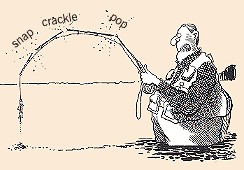|
Every now and then, it's nice to add to your collection of
new toys. Fly rods seem to be perfect additions to the
collection, even if you already have a dozen or more.
Unfortunately, a few people have problems with their new toys,
breaking them within a few trips to the water. They usually
look puzzled when they hear that sickening "snap" that indicates
that a new rod has declined the challenge.
I meet a lot of people who seem to feel that the retailer is
obligated to replace any fly rod as soon as it breaks, and
without questions. Unfortunately, that usually isn't the way
the warranty is written, so one unhappy customer growls and
complains as their rod is packaged to send it back to the
manufacturer for repairs. The groaning increases when they
learn that most rod companies charge a small fee for handling
or whatever you want to call it. It gets worse when they learn
that they will also pay the shipping and insurance required to
ship the rod to the manufacturer for repair.
Ok, I didn't break the rod. In fact, I have only broken two fly
rods in my lifetime. Compare that with some guys who can break
two rods in a day and a couple I know that have busted the same
rod four times in a summer. It gets pretty easy to see why any
retailer would charge the customer the shipping costs to send
his/her rod in for repair.
The sad fact is that most rods break from the actions of the
fisherman. Sometimes those actions are obvious, like shutting
the rod in a car door or trunk lid. Other times the breakage
is less obvious and less predictable, mainly because the fisherman
didn't know the risks associated with his/her actions. Here are
a few of the more common reasons rods break.

Error 1 - Blast it with a bead-head.
Gary Loomis once told me that the number one reason fly rods break
in the hands of customers is slapping the rod with a bead-head fly.
He went on to say that a fly travels roughly the speed of a pellet
shot from a pellet rifle. Would you shoot the tip of your fly rod
with a pellet rifle? We both know how that would turn out. Hitting
your rod tip with a bead-head fly produces similar results.
I'm a pretty good fly caster, and I know line control very well.
I know how to open up my loop and place my fly line on a different
plane than the rod is traveling. However, I rarely fish bead-head
flies; and if I do, I always use a rod I think I can do without for
a couple of weeks or months. I cast well, but it only takes one gust
of wind to send that fly into the rod tip, so I'm very careful to
watch how I cast and only use rods I'm not totally in love with if
I'm casting a bead-head fly. It just makes sense to be cautious.
Error 2 - Transport the rod uncased.
We all know better than this. We carefully case the rod before
we go home, leave it cased until we arrive at the stream next trip,
then throw the uncased rod in the vehicle for that short trip to
the next fishing spot. Snap. It's a sound that turns the stomach.
If the car door or trunk lid don't get the rod, something will fall
on it or slide against it at just the right time to cost you some
money and time. It'll ruin your trip for sure.
I'm not sure why we get into such a big hurry. We all know why
rods come with tubes, but like those kids we get to raise, it
can't happen to us. At least that's what we think, until it
does happen.
Error 3 - Sticking a partially assembled rod in a rod/reel case.
Have you ever done this? You hook the fly on a guide on the top
half of the rod, break it down and shove the two halves into a
rod case. Maybe you're just driving a couple of miles and you
don't want the rod to go uncased, so you cut just one little
corner. It should be safe, right?
According to one rod maker, this is the second most common way
to break a fly rod. Usually, the fly catches on the fabric in
the rod tube, the tip bends from the stress and something breaks
(the rod tip). Does it really take that long to tie the fly back
on the tippet? Is it worth the risk? The snapping sound you
hear in the rod tube will answer that question.
Error 4 - Bill Dance fish playing course.
If you ever watch Saturday morning fishing shows, you probably
watch Bill Dance teach the world how to catch and land fish.
I wonder how many rods he breaks in one show? He nearly falls
backward out of his boat seat when he sets the hook, then he
doubles the rod while applying the least possible pressure on
the fish. That doubled rod might be ok if it's an Ugly Stick,
but it will break almost every time if it's a quality graphite
fly rod. Putting that kind of bend in a fly rod nearly always
results in rod failure. The snapping sound will tell you when
you overstressed the rod.
Error 5 - The crane lift.
Here's another way to overstress a fly rod. You learned your
lesson on setting the hook, so you set the hook and play the
fish perfectly until it's time to land Mr. Fish. The fish
isn't all that big, so you decide to just lift it out of the
water and remove the hook. About the time you get the fish
in the air, it starts wiggling and the tip of you rod starts
bouncing like a paint shaker. One wiggle, two wiggles, three
wiggles, snap.
This time it was the shock of the repeated bouncing and extra
weight that broke the rod tip. Overstressing the rod tip will
do that sometimes. You paid good money for that net, you should
get some use out of it. It might save you some cash and it might
keep you out of the repair cycle.
Error 6 - The famous rod-eating willow.
Two rods down and one last backup to go. This time you hooked
a willow on the far side of the stream and you decide to break
the fly off so you won't disturb the fish. Do you lay the rod
down and grab the line to break the fly off? No, that takes
too much time and effort.
Most people in this predicament use the rod and varying degrees
of pulling to try to break the fly off. If the rod doesn't break
from the stress, it'll probably shatter when the tippet breaks
and shoots the line back into your face.
It's far less costly to lay the rod down and break the fly off
with your hands rather than using the rod to break the line.
Of course, if you don't mind being separated from your fly rod
for a few weeks, just continue trying to break the fly off with
that jerking motion.
Error 7 - Creepy crawler hands.
What's the first thing you do when a big fish is near the shore
or the boat and you want to apply more pressure on the fish?
If you place your hand on the rod blank just up from the handle,
expect that snapping sound. Handles distribute the stress of
a bent rod evenly. Grabbing the rod anywhere else will
overstress the rod at the location of your hand. Since the
rod can't handle the stress, it will break right where your
hand is placed.
Error 8 - The boat oar bandit.
You're moving from point A to point B, so you rest the rod on
the side of the boat and look for a snack while the guide rows.
That snapping sound is a familiar sound, so you look at your
rod and discover how well quality rods handle a chance meeting
with an oarlock and oar.
Error 9 - The javelin thrust.
You're walking along the path with your rod leading the way.
The day is nice and the birds are singing. You look away for
a moment and the rod tip catches on a twig or the ground. Snap.
It wouldn't have happened if you had turned the rod around and
let the tip follow you down the path.
Error 10 - The rock raven.
Graphite is strong in its own way, but it can't handle impact
from a hard, sharp object. If you drop your fly rod on a rock
or similar hard object, expect the fibers in the rod to break.
Your rod might not break with the first fish, but eventually
it will break down and snap at the point of impact. Remember
that rod tube? There's a reason to protect the rod from impact.
Error 11 - The science project.
You made it through the day without breaking anything, so you
put the rod in its tube and leave it that way until the next
time you need it. Unfortunately, the rod was wet when you put
it away and something mysterious is growing in that rod tube.
Mold and mildew smell bad. Delaminated handles don't look good
and don't feel right. Leave the science projects in school.
Open that rod tube and let the fly rod and sock dry thoroughly
before you put it away.
Like the earlier columns in this series, other things can be
added to this list. An ounce of common sense will go a long
way towards preventing rod breakage. Taking the time to do
things right should handle the rest.

Tight lines. ~ AC
|


